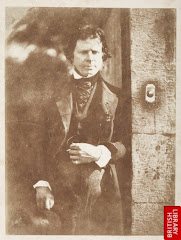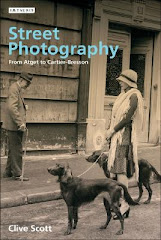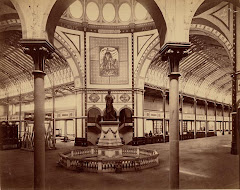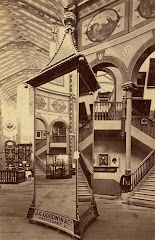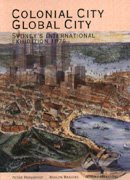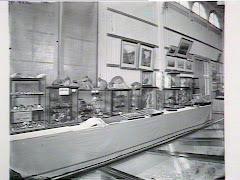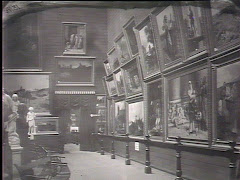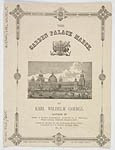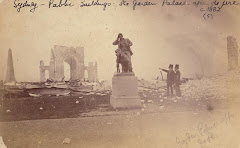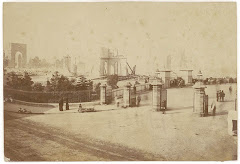The following YouTube video includes black and white images by famous photographers Alfred Stieglitz, Berenice Abbott, Eugene Atget, Jacob Riis, Alfred Eisenstaedt, Henri Cartier-Bresson, Diane Arbus and Walker Evans.
Tuesday, September 2, 2008
Monday, September 1, 2008
"Pencils of Light" - Edinburgh Calotype Club
The National Library of Scotland is currently showcasing two albums in its digital library of the first photographic club in the world - the Edinburgh Calotype Club - formed in the early 1840's. These albums are among the earliest photograph albums in the world. Volume 1 is held in the National Library of Scotland and Volume 2 in the Edinburgh Central Library. The albums contain over 3oo images assembled by a group of Scottish photographers who belonged to this Club of professionals - mainly advocates, doctors and academics working in Edinburgh and St. Andrews.
In one of the albums there is a photograph of a Kitchen Hut at Gnarkeet Station, in Port Phillip. This was a squatting run of 28,290 acres, located 100 miles west of Melbourne owned by Robert Tennent and Charles Hugh Lyon from 1844 to 1853. This picture was taken by Robert Tennent (date unknown).
To view the images in the Calotype albums and to read more about the history of the Edinburgh Calotype Club and the Calotype photographic process, click on the link below:
http://www.nls.uk/pencilsoflight/index.html
In one of the albums there is a photograph of a Kitchen Hut at Gnarkeet Station, in Port Phillip. This was a squatting run of 28,290 acres, located 100 miles west of Melbourne owned by Robert Tennent and Charles Hugh Lyon from 1844 to 1853. This picture was taken by Robert Tennent (date unknown).
To view the images in the Calotype albums and to read more about the history of the Edinburgh Calotype Club and the Calotype photographic process, click on the link below:
http://www.nls.uk/pencilsoflight/index.html
Web 2.0 technology
Through digitisation and Web 2.0 tecnhology historical photographs like these can be shared with a wider audience by libraries and museums from around the World. In more recent years Web 2.0 technology has also enabled organisations and individuals to upload and share their photographs through online photo communities such as Flickr.
The value of a blog for the State Library of New South Wales is that it provides the opportunity to learn how our clients view us and to find out what they would like the library to be involved in. A blog provides the forum to enable bloggers to share their own historical photographs and background knowledge - a useful information-gathering exercise for the Library. There is also the opportunity to further showcase and promote the State Library of NSW collections, events and programs in an informal but informative way and to invite comment and share knowledge on historical, unique and rare items within the collection.
The value of a blog for the State Library of New South Wales is that it provides the opportunity to learn how our clients view us and to find out what they would like the library to be involved in. A blog provides the forum to enable bloggers to share their own historical photographs and background knowledge - a useful information-gathering exercise for the Library. There is also the opportunity to further showcase and promote the State Library of NSW collections, events and programs in an informal but informative way and to invite comment and share knowledge on historical, unique and rare items within the collection.
Thursday, May 15, 2008
Looking at Life Through A Lens
Henri Cartier-Bresson a French 20th Century photojournalist commented that "photographers deal in things which are continually vanishing and when they have vanished there is no contrivance on earth which can make them come back again."
Many 19th Century photo-historians also captured their passion for photography with a myriad of images that today provide us with an invaluable insight into significant moments of the past that have now vanished.
The Garden Palace and Sydney International Exhibition photographs featured in this blog are held in the State Library's Pictures Collection. They are an important record and story of a significant period in Sydney's history and of the great loss of an exceptionally grand architectural structure that dominated Sydney's harbour landscape from 1879 -1882. The Collection holds many photographs of the interior and exterior construction of the Palace, the varying exhibits at the Sydney International Exhibition of 1879 and the final images of the ruins of the Palace after its destruction by fire in 1882.
The Garden Palace was constructed by the architect James Barnet in what is now Sydney's Royal Botanical Gardens. Modelled on London's Crystal Palace it was designed and built in 1879 to house the Sydney International Exhibition of the same year. The exhibition attracted representation by 18 other countries with displays of world products and advanced manfacturing and industrial technology. There was also a South Pacific anthropology collection, horticultural exhibits, art galleries and daily musical concerts.
The selection of photographs featured in the slideshow below can be accessed in the pictures collection of the State Library of NSW.
Many 19th Century photo-historians also captured their passion for photography with a myriad of images that today provide us with an invaluable insight into significant moments of the past that have now vanished.
The Garden Palace and Sydney International Exhibition photographs featured in this blog are held in the State Library's Pictures Collection. They are an important record and story of a significant period in Sydney's history and of the great loss of an exceptionally grand architectural structure that dominated Sydney's harbour landscape from 1879 -1882. The Collection holds many photographs of the interior and exterior construction of the Palace, the varying exhibits at the Sydney International Exhibition of 1879 and the final images of the ruins of the Palace after its destruction by fire in 1882.
The Garden Palace was constructed by the architect James Barnet in what is now Sydney's Royal Botanical Gardens. Modelled on London's Crystal Palace it was designed and built in 1879 to house the Sydney International Exhibition of the same year. The exhibition attracted representation by 18 other countries with displays of world products and advanced manfacturing and industrial technology. There was also a South Pacific anthropology collection, horticultural exhibits, art galleries and daily musical concerts.
The selection of photographs featured in the slideshow below can be accessed in the pictures collection of the State Library of NSW.
Subscribe to:
Posts (Atom)
